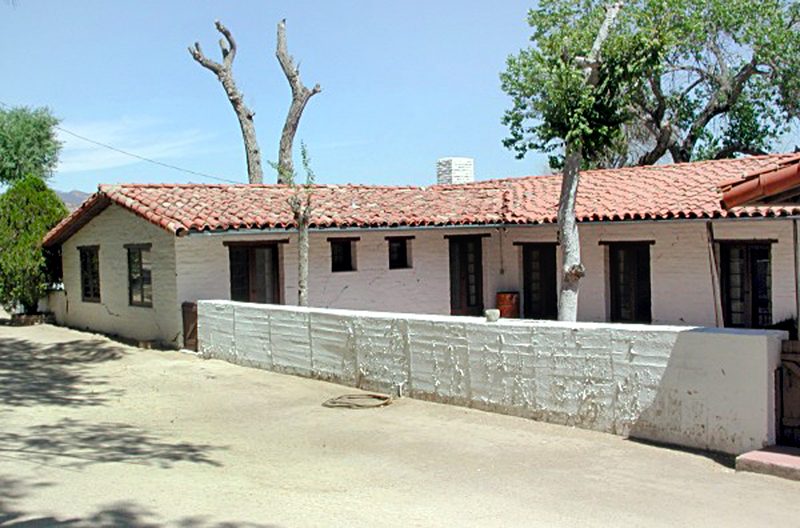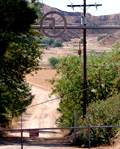|
|

Click image to enlarge
Aug. 15, 2001: The U-shaped Harry Carey Ranch House was built by actors Harry and Olive Carey on their San Francisquito Canyon ranch in 1932 when their original wood-frame house burned down. They occupied the adobe home from 1933 until 1944, when they sold the property. It changed hands twice before it was acquired by Bernard "Barney" and Francis Clougherty, owners of the Farmer John line of meat products. The ranch house is the centerpiece of the Harry Carey Historic District and is being preserved by the developers of the Tesoro del Valle housing project. Plans call for it to be operated as a museum by the Santa Clarita Valley Historical Society. Update: The County of Los Angeles Department of Parks and Recreation, not the SCV Historical Society, maintains an approx. 1-acre piece of the Harry Carey Ranch property as the Tesoro Adobe Historic Park. It opened to the public in 2005.
About Harry Carey Sr. Actor Harry Carey (Sr.) acquired a homestead at the mouth of San Francisquito Canyon in 1916 and established a rancho. The ranch included the Carey's wooden ranch home as well as several outbuildings and the Harry Carey Trading Post, which was a tourist attraction that included billed entertainment from Navajo Indians and other performers, along with a store that sold Western and Indian curios. The ranch was occasionally used for filming. The Careys' son, Harry Carey Jr. (Dobe), who would follow in his father's acting footsteps, was born in the Carey ranch home in 1921. The trading post washed away in the St. Francis Dam disaster of March 1928 and was not rebuilt. The Indians left about a month earlier, son Dobe said in a 2005 interview. Dobe said a shaman saw "a big crack and predicted it would break." The ranch house was situated at a higher elevation and survived the flood, only to burn down in 1932. The Careys replaced it by building a Spanish adobe home, which they sold with the rancho in 1945. Harry Carey was born Henry DeWitt Carey II on January 16, 1878 on 116th Street in the Bronx section of New York City. His father was a special-sessions judge and president of a sewing machine company. Harry attended a military academy but declined an appointment to West Point, instead trying his hand as a playwright. According to the Internet Movie Database: In 1911, his friend Henry B. Walthall introduced him to director D.W. Griffith, for whom Carey was to make many films. Carey married twice [correx: 3 times; see here], the [third] time to actress Olive Fuller Golden (aka Olive Carey), who introduced him to future director John Ford. Carey influenced Universal Studios head Carl Laemmle to use Ford as a director, and a partnership was born that lasted until a rift in the friendship in 1921. During this time, Carey grew into one of the most popular Western stars of the early motion picture, occasionally writing and directing films as well. In the 1930s he moved slowly into character roles and was nominated for an Oscar for one of them, the president of the Senate in "Mr. Smith Goes to Washington" (1939). He worked once more with Ford, in "The Prisoner of Shark Island" (1936), and appeared once with his son, Harry Carey Jr., in Howard Hawks' "Red River" (1948). He died Sept. 21, 1947, in Brentwood, after a protracted bout with emphysema and cancer. Ford dedicated his remake "3 Godfathers" (1948) "To Harry Carey — Bright Star Of The Early Western Sky." Carey would appear in at least 233 films, including short features, between 1909 and 1949. Further reading: Harry Carey Ranch: Historic American Buildings Survey No. CA-2712.
LW2142c: Digital image by Leon Worden |
• Harry Carey Ranch Survey 2001
Survey Photos (86)
Living Room Furniture
SEE ALSO:
Interview: Dobe & Cappy Carey 2005
Video: Dobe Returns 2009
Ranch 1920s
Trading Post 1920s
Interior 1920s
Navajo Rug Room
Trading Post 1910s-20s
Arrow Sign 1920s
Tourists 1920s
Performers 1920s
Baking Bread 1920s
Hosting Film Critics 1921
1st Ranch House
Carey & Rübel Kids ~1940
Ranch Buildings
(Multiple)
Tesoro: Homes Planned 1992
Dobe (x2) 2005
Monument Dedication 5-2-2015
Tesoro Phase A-B-C EIR 2/2018
Tesoro (San Francisquito) Bedrock Mortar
|
The site owner makes no assertions as to ownership of any original copyrights to digitized images. However, these images are intended for Personal or Research use only. Any other kind of use, including but not limited to commercial or scholarly publication in any medium or format, public exhibition, or use online or in a web site, may be subject to additional restrictions including but not limited to the copyrights held by parties other than the site owner. USERS ARE SOLELY RESPONSIBLE for determining the existence of such rights and for obtaining any permissions and/or paying associated fees necessary for the proposed use.


























